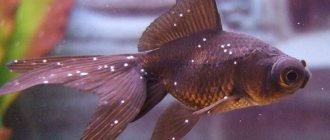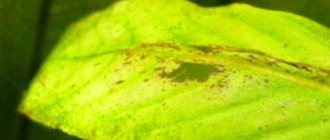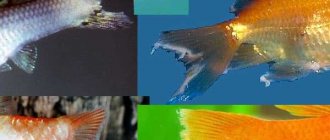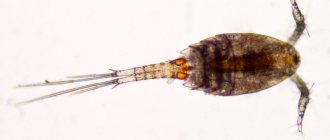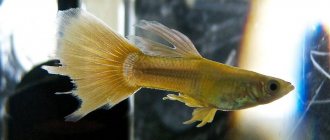- Where does it come from?
- Symptoms of the disease
- Which fish are susceptible to the disease?
- Initial stage of the disease
- Transition to intensive treatment
- Aquarium treatment
- Prevention
- When is it useless to treat?
It’s unpleasant when ornamental fish start to get sick. But this does not mean that they will die and you will have to make new ones. Most diseases can be treated. Although it is better to prevent them, regularly monitor the condition of underwater inhabitants and the cleanliness of the aquarium. Fin rot - it is this disease that often causes trouble for owners and leads to the death of fish. What are its causes, symptoms, what should be done to save all the living creatures in the aquarium?
Where does fin rot come from?
The causative agent is the bacterium Pseudomonas fluorescens.
It lives in natural reservoirs, and enters the home tank through food, soil, decor, or from new fish from the store that have not been quarantined. Advice!
After purchasing, do not immediately place the fish in the aquarium. Leave them in an old tank of store-bought water for a couple of days. Gradually add water from your vessel to it. The fish need to get used to the new environment. In addition, you will make sure that the new underwater resident is non-infectious. The infection destroys the fish's fins, they become torn, worn out, and injured. Inexperienced aquarists think that this is mechanical damage, so they do nothing, and the pets die. The danger is that there is little time for treatment, the disease develops quickly. The main causes of infection include:
- dirty water, no filter;
- untimely or poor cleaning of the aquarium;
- failure to comply with the required temperature conditions;
- increased acidity level;
- stress factors (therefore you need to take care of the comfortable existence of the fish, choose the right decor, additional equipment).
Malachite green
So, let's look at the first remedy, which is still very often used to treat semolina disease in fish. This treatment is quite safe, which is why it has earned the trust of aquarists for many years. This is an organic dye, it does not interfere with the biological filtration of water, it can be added directly to the general fish house. The dye practically does not harm plants. The optimal concentration is considered to be 0.09 mg/l. Please note that for some fish this concentration is too high. These are shark catfish and labeo, botia, for which the concentration should not be more than 0.04 mg/l. However, in this case, the effectiveness of treatment drops sharply.
Judging by the observations of aquarists, even very sensitive fish normally tolerate a concentration of 0.06 mg/l. “Semolina” is a fish disease that is quite easy to diagnose and treat, it can be seen with the naked eye, and every beginner can introduce drugs into the water. So, malachite green is added to the water every day. This must be done until the signs of the disease disappear. After this, it is enough to extend the therapy for another two days. Before adding malachite greens, it is necessary to replace 25% of the water, and if you add 5 drops of iodine per 100 liters, the effectiveness of treatment will increase significantly.
In this case, it is necessary to maintain the water temperature at least 26 degrees and turn off filtration. After the course of treatment, you need to completely change the water and rinse the soil, although experienced aquarists advise simply placing the fish in another container for the duration of treatment, and raising the temperature in the main aquarium to 32 degrees. So the ciliates will quickly emerge from the larvae and, not finding fish for themselves, will die.
Symptoms of the disease
If you notice the following condition even in one fish, immediately proceed to treatment:
- Change in fin color. They turn light blue. Cloudiness begins at the edges and spreads to the entire organ. This symptom is clearly visible in fry with transparent feathers;
- Blockage of blood vessels, which manifests itself in the form of red stripes and spots;
- Rot starting from the edges;
- Blurred eyes;
- Breaking off fins;
- Ulcers throughout the body (appear in the last stage of the disease)
You can see what fin rot looks like in the photo; inexperienced aquarium owners often do not notice it.
Which fish are susceptible to the disease?
All species of fish can become infected with the disease, especially if the immune system is weakened, but more often fin rot occurs in fish with large, long, folded fins:
- in swordtails (fins slowly decrease, tail erosion begins, and a white coating appears);
- in goldfish (the edges of the fins become cloudy, split, and become short);
- in guppies (at first the fins turn pale, become thin, and fall off);
- in angelfish (red stripes appear, then ulcers);
- in cockerels (in these species, rot is immediately visible, since they have a red color that changes to white and blue);
- in cichlids (white coating, destruction of fin rays and the entire tail).
Similar symptoms can be seen in barbs, catfish, astronotus, and zebrafish. If the fish are very young, the disease is more complicated, often with a fatal outcome. An individual approach is needed in the treatment of fish; angelfish, for example, should not be kept in a hatchery; they do not tolerate being moved well, and males only recover in quarantine.
Recognizing the symptoms
Usually the first symptoms of the disease are not too pronounced. The inhabitants of the aquarium continue to swim merrily and actively feed, but several dots or specks appear on their bodies. It is immediately necessary to figure out whether this is really a “semolina” disease in fish. Treatment may be radically different when it comes to other bacterial or fungal infections. That is why you need to have a good understanding of what disease you are dealing with. This could be dermatomycosis, which is also characterized by white dots on the surface of the body. However, they gradually turn into a fluffy coating. Another dangerous disease, lepidorthosis, may also be similar in appearance. You may observe fluid-filled pustules forming on the skin. Lymphocytosis manifests itself as small white nodules or plates that gradually grow. Many other diseases also cause white speckling on the skin, so you may need the help of an experienced aquarist to make the correct conclusion.
Initial stage of the disease
Treatment of fin rot in a community aquarium should begin immediately; at an early stage, the infection is easy to neutralize. Carefully remove the infected fish to a separate tank of purified water. Do the same action with other inhabitants. The aquarium is emptied as it needs a thorough cleaning. At the initial stage, a simple change in the living conditions of the fish and the destruction of the infection with medications helps. The water is heated to the highest possible temperature, sea salt is added, if acceptable for this species, and potassium permanganate baths are made. In 90% of cases, these actions help, and the colorful underwater inhabitants live for a very long time in their house.
Interesting! A female eel has set an unreal record among aquarium fish. She lived to be 88 years old! She was caught in 1860 in the Sargasso Sea, and she died in 1948 in one of the museums in Helsinki.
Phases of the wound process
- Purification stage
If there is copious purulent discharge or the presence of necrosis or an unpleasant odor, the ulcer must be cleansed of infection and dead tissue. This is achieved by washing the ulcer with a sponge soaped with laundry soap. To separate dead tissue, chymotrypsin powder or mesh with enzymes (parapran) is used, which is placed into the ulcer after washing and covered with a napkin. Dressings are repeated 2 times a day before bedtime and after waking up. Before each dressing, the ulcer is washed with a soft sponge and laundry soap. In the morning, a compression stocking or golf stocking of 2-3 compression class is put on over the bandage; in extreme cases, a fresh elastic bandage is used. If the skin around the ulcer is eczematous, then it is necessary to reduce inflammation; if there is redness of the skin around the ulcer, hormonal ointments (Lorinden, fluorocort) are used, which are applied in a thin layer under a dry cloth at night and not rubbed in. Hormonal ointments are used for no more than 5 days.
- Healing stage (granulation)
When good granulations appear - the ulcer is bright red, relatively clean, and its depth is reduced, treatment is required to stimulate healing and protect the granulations from damage. We use special wax mesh (voskopran) on top of which we apply ointments that promote healing - olasol, curiosin, gel dressings. The compression rules remain the same. You can wash the ulcer at this time without a sponge and carefully. Dressings once a day. Improving blood flow is achieved by elevating the leg during sleep (15-20 degrees), and mandatory compression with a stocking or bandage while awake. Elastic compression is necessarily used for venous ulcers; for arterial ulcers it is contraindicated, since on the contrary it can cause harm.
- Epithelization stage (final covering with new skin)
After the ulcer begins to heal, only light protective coverings like the same mesh are used, and gel dressings such as “hydrocol” can be used. If a small dry crust forms, there is no need to remove it specifically. After the appearance of young skin, it will fall off by itself. For venous ulcers, after eliminating venous congestion (sclerotherapy, laser or surgery), the ulcerative surface closes in 2-6 weeks. For arterial ulcers, the situation depends on the degree of restoration of blood circulation. With good blood circulation, ulcers usually heal within 1-3 months.
Transition to intensive treatment
How to treat fin rot in a community aquarium if improving conditions does not help? There are many options. These are traditional methods, popular antibiotics, antibacterial agents. Medicine for fin rot should be purchased in specialized stores and pharmacies. Tetra General Tonic, Tetra Goldfish GoldMed, Sera baktopur and opnipur, trypaflavin, and aquarol have proven themselves well. They contain an antibiotic, so they easily kill bacteria. But make sure that the preparations do not contain dyes, they will kill your pets. Among the more accessible treatment options for fin rot, the following should be noted:
- Levomycetin. One tablet is diluted in a small amount of water, the solution is poured into a common tank in a ratio of 1:20. Treatment with chloramphenicol is repeated every 3 days;
- Streptocide. It is diluted in warm water (27 degrees), poured into a vessel, or separate baths are made for infected fish.
- Bicillin-5. Treatment with bicillin-5 lasts 6 days, each time one part of the bottle is consumed. During use, it is recommended to darken the aquarium; in light, the antibiotic decomposes. Disadvantage – kills living ornamental plants;
- Biseptol-480. For 5 liters, 1/8 of a tablet is enough. The fish must be constantly in this solution; it is important to ensure aeration.
- Salt. The standard dosage is 7 grams per 6 liters of water. The fish are placed in such a bath for half an hour twice a day. To cure cockroaches and corydoras, the concentration should be reduced;
- Furacilin. Treatment in a community aquarium with furatsilin lasts up to 2 weeks, sometimes twice a day is enough. The required amount for 30 liters is 1 tablet 0.02 grams. The drug does not have a negative effect on fish health and water biobalance. There is no need to remove filters during use;
- Treatment with Antipar. This is a special solution for the treatment of ornamental fish based on malachite blue, malachite green, and formaldehyde. It is better to use it in the evening before bedtime for “patients”, reduce the lighting intensity, remove sorbent filtration;
- Hydrogen peroxide. A 3 percent solution is needed. It is dissolved in a separate container and then added to the aquarium. If you pour it directly into the tank, you can easily burn the fish. Treatment will take 1 to 2 weeks. Peroxide oxidizes and destroys organic bacteria, so do not forget to constantly change some of the water.
- Malachite green. It is needed in the form of oxalate, other types are toxic. It can stain objects and harm the biobalance of the underwater microcosm. Not effective in alkaline environments. Used to process fish in a bath.
- Give antibiotics as directed for no longer than prescribed. Any medications for fin rot absorb oxygen, so you need to enrich the aquarium water with it by installing a compressor or air spray.
Note! If you have bettas living in your vessel, set the air supply to low. Strong currents will harm these fish.
"Antipar" - a cure for "semolina"
Today, this is the most effective remedy against a wide variety of diseases that you can encounter if you have an aquarium at home. The drug has antiparasitic, antibacterial and antifungal effects. It is used to effectively cure fish of ichthyophthyriasis, secondary bacterial infections, as well as many other ailments. The main active ingredients are malachite green and formaldehyde. That is why the liquid has a specific odor and blue-green color. Features of the drug This remedy for “semolina” in fish is sold in the form of a liquid solution.
Its action is based on the fact that fungi and bacteria, as well as helminths and protozoa parasitizing fish, die, since the main active ingredients of the drug completely disrupt their metabolism. At the same time, the drug accelerates the healing of skin lesions. This is a moderately hazardous substance with little toxicity to fish. In this case, different types of treatment are used. For prevention, you can use a short-term, three-hour bath, with the ratio of water and medication being 1 ml per 10 liters. The same method is used for treatment, only now not once, but at least twice with an interval of one day.
Aquarium treatment
If fin rot is detected in the fish, the tank is completely emptied, including soil, decor, and special equipment. All contents are washed with warm and then hot water, dried with paper towels. The aquarium is thoroughly washed, but without using soap, and disinfected with a chloramine solution. The water is completely replaced. The ideal temperature is 26-28 degrees. You should definitely check it for the presence of nitrates, nitrites, and pH levels. You can add a few drops of tea tree. We strongly recommend seeking professional help to start up your aquarium after illness. This guarantees no relapse.
Interesting! Tea tree oil is not inferior to medical drugs in its antibacterial properties. It is used to get rid of wounds and swelling, to destroy fungus, mold, and unpleasant odors. It kills insect poison and helps in the fight against moths and garden pests.
Branded medicines for semolina
A lot has been said about how to treat ichthyophthyriasis in fish, but some previously unknown drugs appear all the time.
Currently, you can find many new medications for semolina with a combined composition. When using them, you need to follow the manufacturer's instructions, but still be vigilant, since some types of fish may be sensitive to certain components, especially formaldehyde. If you are using a drug for the first time, start with a lower dose (for example, 2/3 of the indicated dose). When you are sure that the fish tolerate the product well, you can add the missing amount - usually this is done after 12 hours.
The most effective medications today are:
- Sera Omnisan - suitable for the treatment of mild forms of semolina, that is, for classical treatment.
- The use of Omnisan together with Mikopur is effective in combating tropical ichthyophthyriasis, and if you add ectopur here, the therapeutic effect will increase even more.
- Aquarium Pharmaceuticals (API) capsules cope perfectly with any form of ichthyophthyrriosis. There is also a liquid dosage form of this product, which includes a wound-healing substance - it is used in advanced cases of ichthic, when a significant part of the fish’s skin is damaged. In the first two days, capsules are added to the water, and then, if necessary, they switch to the liquid form of the drug.
- JBL Punktol ULTRA - includes malachite green, crystal violet and methylene blue. They are used to treat severe forms of the disease, while combining them with JBL Ektol crystal.
Prevention
To minimize the likelihood of your fish becoming infected with the disease, change the water in the aquarium regularly, for small tanks - once every 3 days, for large tanks - once a month. Don’t forget to wash decorative elements and gravel. It is advisable to add special salt to the water. Select fish, taking into account not only your own tastes, but also the advice of experts. For example, angelfish, pufferfish and catfish bite the tails of friendlier fish. Do not overpopulate the tank; pets do not need stress, and underwater inhabitants become aggressive in such cramped conditions. Make sure that decorative accessories remind the fish of their native habitat so that they can hide. A good option is grottoes, driftwood, shells. But make sure that all decor is safe; mechanical damage in dirty water is a direct path to infection.
Don’t skimp on food, choose products from trusted manufacturers who monitor the quality of the product. Follow the regime, give it at the same time. Vitamins to boost immunity won't hurt either. You should not overfeed your fish. Leftover food is additional bacteria.
Reasons for development
Inflammation does not appear on its own.
The causes of prostatitis can be divided into bacterial and non-bacterial. The acute infectious variant usually occurs in men under 35 years of age due to damage to the prostate gland by gram-negative bacteria - Escherichia coli, Proteus, Enterobacter. Inflammation also occurs due to infection with sexually transmitted infections - gonorrhea, chlamydia. In the chronic form, there may be many more reasons and the list will include atypical microbes.
Provoking factors for the development of the bacterial variant are:
- unprotected sexual intercourse;
- AIDS or HIV infection;
- diarrhea or constipation;
- anal intercourse;
- sedentary lifestyle;
- inactive sex life;
- diabetes;
- hypothermia;
- violations in intimate hygiene.
Non-infectious prostatitis in chronic form is detected in men who complain of prolonged pain in the genitals, but tests do not diagnose bacteria that could cause inflammation.
The exact cause of the development of this type of prostatitis has not been studied, but the following are considered provoking factors:
- emotional disorders;
- autoimmune diseases;
- increased physical activity;
- lack of regular sex life;
- work involving heavy lifting;
- chronic stress;
- congestion in prostate tissues;
- previously confirmed fibrotic changes in the prostate (according to TRUS results).
It is believed that inactive sex life, unprotected sexual intercourse, and hypothermia play a major role in the onset of the disease. Symptoms of prostatitis are experienced by 50% of the entire male population of the planet at least once in their lives.
When is it useless to treat?
If the feather is completely destroyed, the rot has spread to the body, and death cannot be avoided. You can understand that it is too late to treat pets by the ulcers that have formed on the bases of dead fins with shiny light pus.
Do not hesitate if you notice symptoms of the disease. If you yourself don’t know how to act correctly and how to treat fin rot in a community aquarium, and you don’t have time for care, contact specialists for emergency first aid for your aquarium. The chances of saving pets are greatest with the participation of experts in their field. will take care of all the care for the inhabitants of the aquarium, bring the necessary medications, treat both them and the tank, and tell you how to prevent the disease in the future. Call before it's too late, the disease is progressing quickly.
